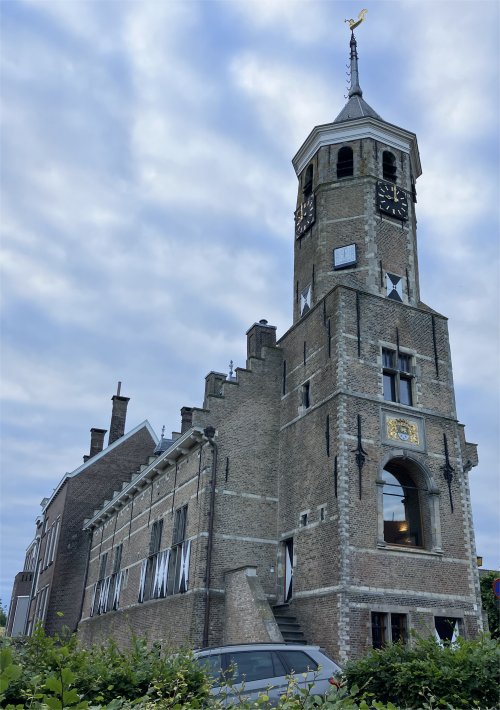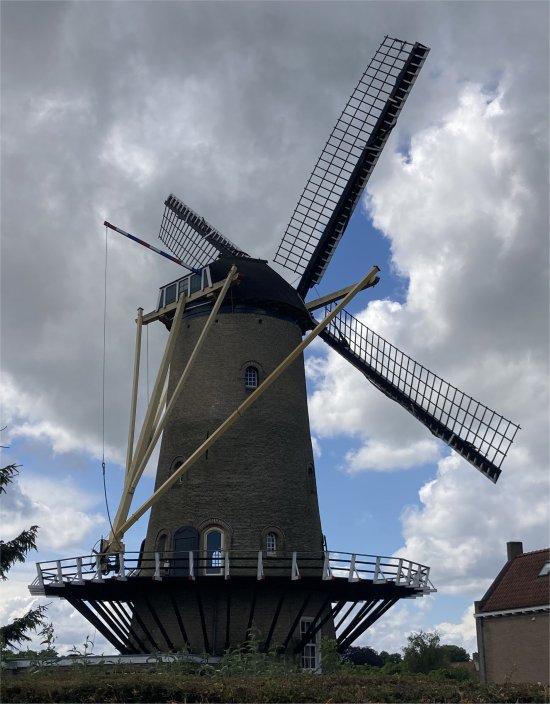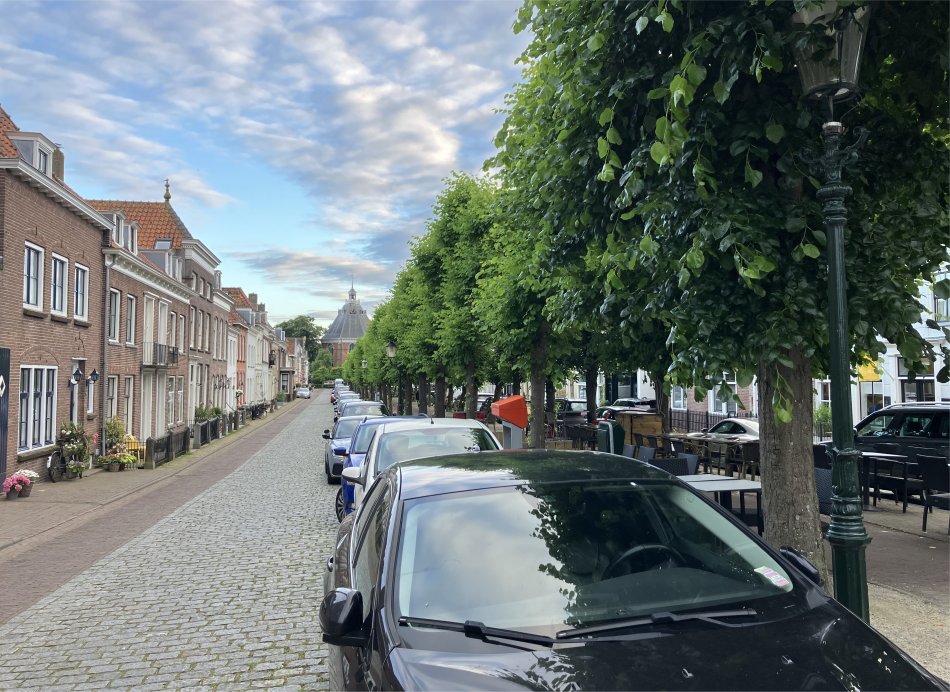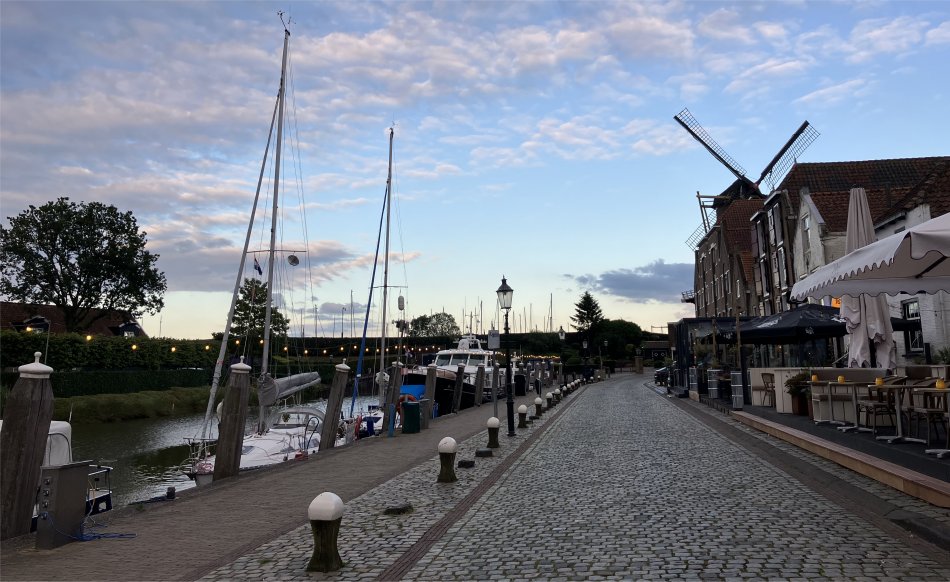 Stadhuis |
By 7am they had opened, and we headed down the canal and steered a course for the Zeelandbrug; we were determined to reach it for the 07:55 opening. A vicious ebb tide was sweeping down the Oosterschelde. We noticed the tide had been so high that a spit of land on our port side was completely submerged.
We reached the opening-bridge in good time, and it opened at 07:55 precisely. As we passed through, we spotted a yacht in the distance racing to reach the opening in time. The bridge wasn't going to stay open for it, and closed shortly behind us. The unfortunate yachtsman would now have half an hour to wait for the next opening.
We continued up the Oosterschelde. Convoys of barges operated in this stretch of water, heading to and from the canals that would give them access to the upper reaches of the Westerschelde. Flotillas of yachts were hurtling down from the Keeten-Mastgat with the tide. For the next 90 minutes we gave mussel trawlers a wide berth, and took in the varied landscape that passed by, carefully picking our passage though hidden channels. Then, after skirting a huge mussel farm, we found ourselves racing against a couple of boats to get into the wind-turbine infested Krammersluizen.
The Krammersluizen separates the salt water of the Oosterschelde from the fresh water of the Volkerak. The locks were part of the Deltaworks project and officially opened in 1987. The locks for inland shipping are 280m long and 24m wide, so they are suitable for large pushers. A second lock for pleasure craft was opened in 1994. Because of the need to prevent an exchange taking place between fresh water and salt water, the locks are technically complicated. The locks are therefore designed so that no salt water flows into the Volkerak and just a small amount of fresh water enters the Oosterschelde. The operation simply applies a fundamental law of physics, denser salt water sinks to the bottom of a lock while the less dense fresh water floats on top. By deploying a complex system of pipes and pumps, salt water from below is pumped out, or from above fresh water is pumped out, depending on the destination of the ship.
Once through into the Volkerak, we encountered large bevies of swans hugging the northern bank. Whenever we'd been this way before, swans always congregated in this stretch of water.
 D' Orangemolen |
At the top end of the Volkerak, at Hellegat, we negotiated another set of locks, the Volkeraksluizen. Now we would be returning back to tidal waters in the Hollands Diep.
As we left the lock, a Dutch boat on the wrong side of the channel shot right across oncoming vessels, earning severe reprimands. The Dutch certainly don't mind ticking off folk who break the rules.
Then it was a relatively short distance through choppy waters, having to judge our moment when we'd make a dash for it through the endless, two-way barge convoys, and make our grand entry into the Batterij Marina at Willemstad. It was blowing fiercely, but fortunately there were willing hands to take our ropes. Locals were battering down the hatches in anticipation of the deluge forecast for the following day, and then they cleared off for home. It took me a while to track down the harbour master; he was doing his rounds on the pontoons making sure all craft were safely secured.
In the early evening, Rex and I enjoyed a pleasant walk around the town, homing in on the Rosmolen restaurant where we enjoyed good food and beer. Beside our table, a long aquarian stretched, full of crayfish and lobsters waiting patiently for their turn to be selected for the pot. Rex gave me a complete diatribe on how I should eat all shell fish, which is something I very rarely do. He then promised he would give me a complete series of lectures on accountancy the following day, and if time permitted, he would teach me how to play bridge. Oh joy! He's been cooped up on the boat too long.
 Voorstraat |
 Town Harbour |
A few metres away, on the quayside, a couple of fishermen caught a 60cm long fish. I tried to find out from them what type of fish it was. Without eye contact, they responded with a monosyllabic, unintelligible word, and that was it.
Further on, two large boats crammed with bikes were moored to the quay, one of which I had spotted in Zierikzee. The craft accommodated the cyclists overnight, the cyclists then using pedal power the next day to reach another destination where their boat would be waiting for them. They are popular all over Europe.
Back on board, Rex decided he wanted to turn the boat around by 180 degrees so that the predicted foul weather would hit the front part of the boat.
"Are you kidding," I said, "getting a boat into and out of a box is a pain at the best of times, never mind trying to do it having just had a meal and a few beers!"
But he was determined. Was he drunk?
But we performed the manoeuvre perfectly. Absolutely brilliant!
